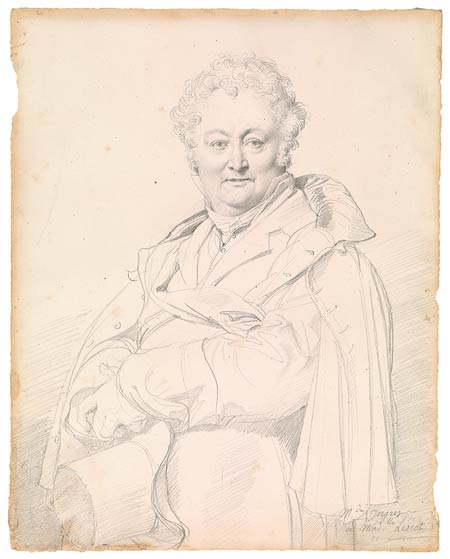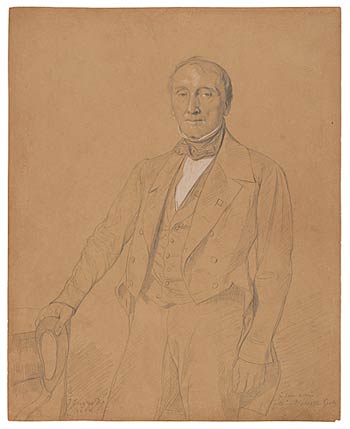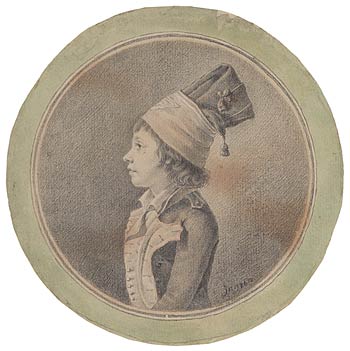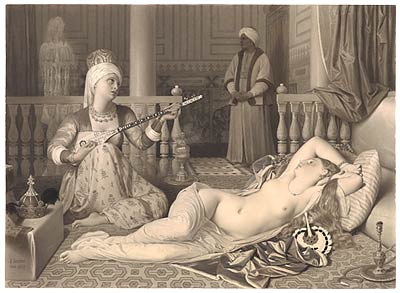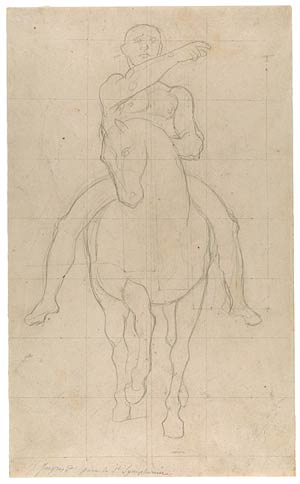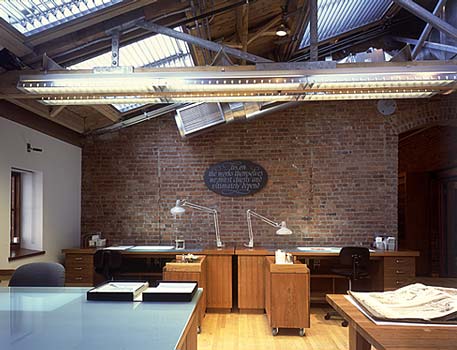This post was created by Morgan Adams, graduate intern from the Conservation Center, Institute of Fine Arts, New York University.
Whether he was making portraits of family and friends or preliminary studies for important history paintings, Jean-Auguste-Dominique Ingres (1780–1867) created drawings of great subtlety and nuance. Close examination of the paper and media allows us to glimpse the working methods of one of the greatest draftsmen and portraitists in French history. Though he employed the simplest of materials—primarily graphite on fine paper—Ingres achieved masterful results. This feature, based on careful study of sixteen exceptional drawings in the Morgan's collection, explores the physical evidence of Ingres's artistic process, from his use of prefabricated drawing boards to his strategies for transferring drafts from one sheet to another.
Some of the images presented here were made with Reflectance Transformation Imaging (RTI), which provides curators and conservators with a valuable tool for the close examination and documentation of drawings. This technique uses photographs taken in raking light to compile a digital topographical map of the surface of an object, revealing information about the manufacture and materials of a work of art.
MEDIA
Ingres skillfully employed all of the prevailing drawing media of his time: graphite, chalk, and pen and ink. Although he drew portraits almost exclusively in graphite, he occasionally used white chalk or watercolor to highlight a detail of his sitter's costume, as we can see in Portrait of Marcotte Genlis (fig. 1) and Portrait of a Boy (fig. 2).
His drawing Odalisque and Slave is remarkable for the cohesive use of graphite, black and white chalk, and watercolor washes, which he combined so seamlessly that it can be challenging to distinguish among them. In this sensuous scene, Ingres plays with differences in his media's color, transparency, sheen, and texture to communicate the tactile qualities of the subjects depicted—from the cool, smooth floor tiles to the elaborate woven textiles. In the lower right (fig. 3), for example, the "fluffy" texture of white chalk enhances the feathers of the fan.
PAPER

Fig. 4. This watermark demonstrates that Ingres chose high quality paper from Robert Williams' English mill. Jean-Auguste-Dominique Ingres. View of Santa Maria Maggiore, ca. 1813–14. Thaw Collection.
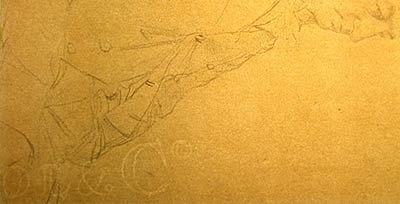
Fig. 5. For this drawing, Ingres chose paper from a fine Dutch mill. Only a portion of the full watermark, "KOOL & Co.," is visible. Jean-Auguste-Dominique Ingres. Portrait of Sylvester Douglas, Lord Glenbervie, 1816. Bequest of Mrs. Jacob M. Kaplan, 1998.
Like many artists of his day, Ingres preferred fine wove paper—an eighteenth-century innovation—over traditional laid paper because its smooth, uniform surface was receptive to even the finest drawn lines. At the same time, the surface of wove paper had just enough texture, or "tooth," to hold the relatively soft media, such as graphite and chalk, that Ingres favored. This surface was essential to Ingres's drawing technique and yet inconspicuous—in these fine white sheets there is nothing to distract the viewer from the subtlety and grace of the artist's line. The wire moulds used to make laid paper, on the other hand, left a rougher surface that was not well suited to fine drawing.
Western wove paper was first made by James Whatman I in England in the 1750s, although it was not widely used until the end of the century. English paper manufacturers were foremost among the producers of fine wove papers, and—not surprisingly—Ingres sought imported English wove papers for his drawings. Among the drawings in this exhibition, two watermarks identify two different paper mills, one in England and one in Holland. A watermark is not a guarantee that a particular sheet was made at the mill identified by the mark, as moulds were valuable implements that were sometimes purchased and reused by other papermakers. Still, watermarks help to localize papers by providing a likely date range and region of manufacture. These two marks demonstrate that Ingres was seeking high-quality materials.
The first watermark (fig. 4), found on the paper Ingres used to draw View of Santa Maria Maggiore, reads "RWILLIAMS," for the English papermaker Robert Williams of Eyehorne Street Mill in Hollingbourne, near Maidstone, Kent, which began making wove paper in the early 1790s. (A similar watermark is found on an 1807 drawing by Ingres, View of Villa Medici, Rome, in the Harvard Art Museum collection.)
The second watermark (fig. 5) is not from an English mill but a Dutch one. Ingres's Portrait of Sylvester Douglas, Lord Glenbervie, has been trimmed so that only a portion of the mark is preserved: "OL & Co." The full mark would have read "KOOL & Co.," for papermaker Jan Kool of the De Bonsem Mill in the Dutch town of Koog aan de Zaan. Kool operated the mill from 1774 to 1816 and his nephew continued the operation until his death in 1837. They produced papers used by many early nineteenth-century French artists.
DRAWING BOARDS
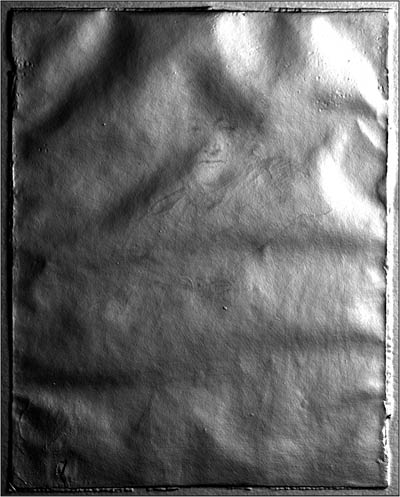
Fig. 6. This image, made with Reflectance Transformation Imaging, shows distortions that indicate that the sheet was once mounted to a prefabricated drawing board. Jean-Auguste-Dominique Ingres. Portrait of M. Guillaume Guillon-Lethière, 1815. Bequest of Therese Kuhn Straus in Memory of Her Husband, Herbert N. Straus, 1977.
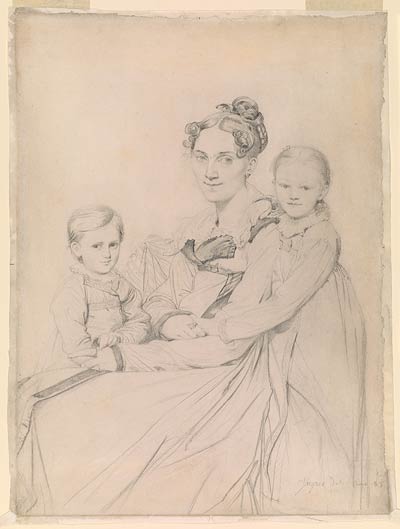
Fig. 7. This sheet was once mounted to a drawing board. Note the crease where the paper was folded around the support, the fractured edges along the crease, and the drawn lines that stop before the crease. Jean-Auguste-Dominique Ingres. Frau Reinhold and Her Daughters, Susette-Marie and Marie-Auguste-Friederike, 1815. Thaw Collection.
Of the eleven portraits in the exhibition, seven appear to have been made on prefabricated drawing boards. These boards consisted of fine wove paper wrapped around a heavier and cheaper support, such as thin cardboard. Sandwiched between the wrapped paper and the support was a high-quality sheet of laid paper that acted as a barrier and cushion between the rough board and the fine drawing paper.
The format provided several advantages to an artist: the drawing sheet was kept taut and made more rigid by the cardboard, and the support cushioned the paper when an artist used a sharp tool, such as the stylus Ingres employed in Portrait of M. Guillaume Guillon-Lethière. Furthermore, the boards were portable: an artist was not tied to a studio but could easily carry drawing boards to a sitter's house for a portrait.
Drawing boards were sold by artists' suppliers pre-prepared, ready for the artist's immediate use. They were likely made by wrapping a dampened drawing sheet around the support board and gluing it in place; drying under this tension resulted in a taut surface similar to a stretched canvas. The drawing paper was only adhered on the edges of the support and on the margins, which were folded around to the back. Because the drawing sheet was not adhered to the front of the support at all, it could be separated the paper from the board without damage. Many of Ingres's drawings made on prefabricated drawing boards have been removed from their supports. Remarkably, evidence of the original format remains in many of the Morgan's drawings today.
A photograph made with Reflectance Transformation Imaging (RTI) of Ingres's Portrait of M. Guillaume Guillon-Lethière, for example, confirms that the sheet was once mounted on a prefabricated drawing board (fig. 6). Looking at the corners of the drawing, it is possible to see the draws—diagonal distortions of the surface—that were made when the sheet shrank slightly as it dried wrapped around the support. The fact that the draws remain in the sheet today indicates that the drawing has never been washed—an important piece of information that will influence any future conservation treatment.
Drawings that have been removed from boards may retain a bit of a crease where the paper was once folded around the support. In the Morgan's collection, such a crease is evident in Ingres's drawing Frau Reinhold and her Daughters(fig. 7). Drawings that were originally mounted on boards may also include drawn lines that do not extend beyond the crease and a slight discoloration following the crease, which might be due to the adhesive used to adhere the sheet to the support, or due to contact with a wooden frame. These sources of degradation also made the drawing papers prone to fracturing along the crease.
REVISING COMPOSITIONS
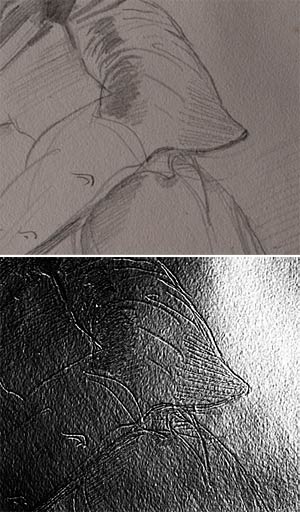
Fig. 9–10. Ingres used a blind stylus to transfer a preliminary drawing to this sheet and then drew over the inscribed lines with graphite. The image on the bottom, taken with Reflectance Transformation Imaging, or RTI, highlights the inscribed lines. Jean-Auguste-Dominique Ingres. Portrait of M. Guillaume Guillon-Lethière, 1815. Bequest of Therese Kuhn Straus in Memory of Her Husband, Herbert N. Straus, 1977.
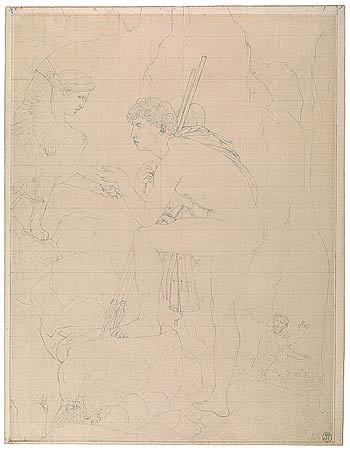
Fig. 11. Ingres divided this drawing into small and large squares to facilitate transferring the image to another sheet. Jean-Auguste-Dominique Ingres. Study for Oedipus and the Sphinx, 1808. Gift of the Ian Woodner Family Collection in Honor of the Seventy-Fifth Anniversary of The Morgan Library, 1999.
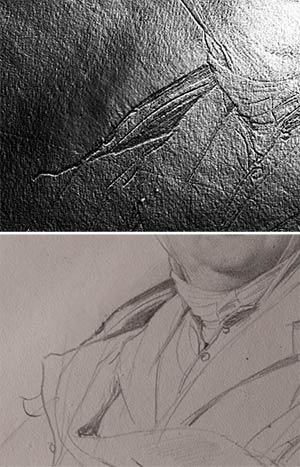
Fig. 12–13. The image on top (taken with Reflectance Transformation Imaging, or RTI), shows that Ingres scraped away an area of the sitter's collar and burnished the paper. The image on the bottom, taken in raking light, shows where Ingres redrew the detail. Jean-Auguste-Dominique Ingres. Portrait of M. Guillaume Guillon-Lethière, 1815. Bequest of Therese Kuhn Straus in Memory of Her Husband, Herbert N. Straus, 1977.
Ingres's preparatory drawings demonstrate how he experimented with elements to be used in other compositions, and, as is to be expected, these studies include a variety of techniques for transferring and editing his work. To copy a design from one sheet to another, Ingres alternated among tracing paper, grids, and inscribed lines.
Ingres used a thin sheet of transparent tracing paper to transfer a preliminary design for Study for the Mounted Centurion (fig. 8). After tracing, the thinness of the paper was no longer an asset, and so he mounted it to heavier laid paper that provided the necessary strength to withstand further drawing and erasing as the artist elaborated the composition.
When tracing paper was not appropriate, such as for a finished portrait, Ingres used a blind stylus to transfer a design from one sheet to another. He would place a sheet of paper under the image to be transferred and trace the outline with a stylus, thus inscribing bare lines in the paper below. The cushion provided by a prefabricated drawing board was essential to prevent the sharp stylus from tearing the drawing paper. Ingres used this technique in Portrait of M. Guillaume Guillon-Lethière (fig. 9–10): he laid out the general composition in inscribed lines, most of which he later drew over with graphite. Looking closely, it is possible to see that the graphite sometimes skips over low points of inscribed lines, indicating that it was applied after the inscribed lines were made.
Ingres sometimes squared a sheet into a grid, either to transfer or scale the composition on another sheet. In Study for Oedipus and the Sphinx (fig. 11), Ingres used larger squares in simpler areas of the composition and quarter-sized squares in more complicated passages, such as the winged figure in the lower right corner and the cliffs in the upper right. He marked points along all four edges with a compass to lay out the grid, then drew in the lines of the grid as needed, using every point for smaller squares and every other point for larger squares.
Ingres's primary technique for removing a drawn line was to scrape the surface of the paper, lifting the top layer of paper fibers and the media embedded in them. This disrupted, roughened area would then be burnished smooth, resulting in a change in the paper's surface texture that is readily apparent when the drawing is examined in raking light. Ingres made very few changes while he worked on his portraits; when he did, it was often in the collars, cuffs, and outlines of the torsos, as seen in his Portrait of M. Guillaume Guillon-Lethière(fig. 12–13).
RESOURCES
Cohn, Marjorie. "Technical Appendix," in Ingres Centennial Exhibition 1867–1967: Drawings, Watercolors and Oil Sketches from American Collections, pp. 241–249 (Fogg Art Museum, Harvard University, February 12–April 19, 1967).
Gravell, Thomas, and George Miller. A Catalogue of Foreign Watermarks Found on Paper Used in America 1700–1835 (Garland Publishing, Inc., 1983).
Krill, John. English Artists' Papers: Renaissance to Regency (Oak Knoll Press and Winterthur Museum, second edition, 2002).
This post was created in conjunction with the exhibition Ingres at the Morgan on view September 9 through November 27, 2011, organized by Esther Bell, Moore Curatorial Fellow, Department of Drawings and Prints. The study of Ingres's materials and methods was undertaken by Morgan Adams, graduate student at the Conservation Center, Institute of Fine Arts, New York University, in consultation with Margaret Holben Ellis, director of the Morgan's Thaw Conservation Center. We are indebted to historian Peter Bower for his work on Dutch papers and to curator and paper conservator Marjorie Cohn for her study of prefabricated drawing boards.

